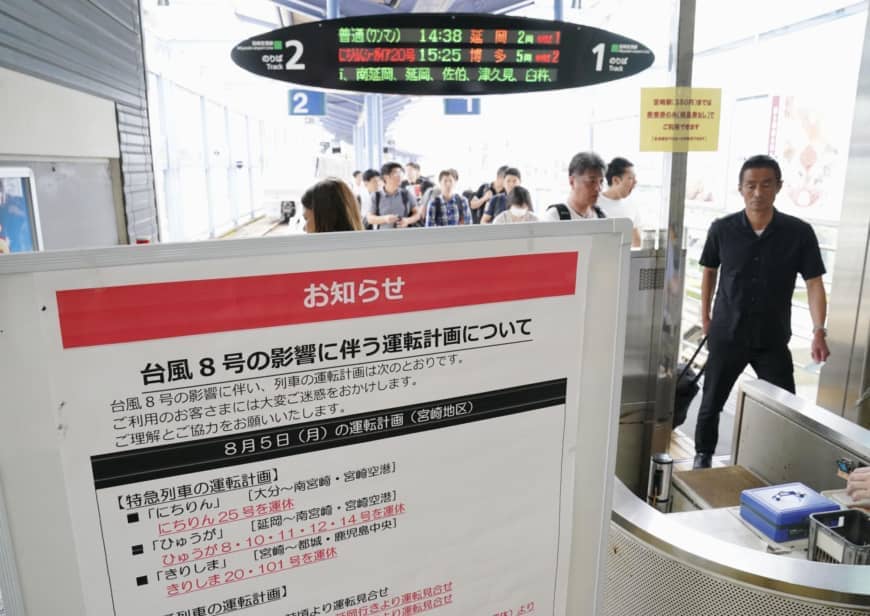Japanese vocabulary for disasters
A notice at Miyazaki Airport Station says the number of train services will be reduced as Typhoon Francisco approached Kyushu in August 2019. | KYODO
Do you know your emergency-related Japanese words? It can make a big difference during and after a disaster. Here is a list of disaster-related terms you should know.
Warning categories
These are the most important terms because they have official weight and indicate the severity of the situation.
- Advisories (注意報 chūihō)
- Warnings (警報 keihō)
- Emergency warnings (特別警報 tokubetsu keihō)
- Bulletins (気象情報 kishō jōhō): provide information to supplement warnings and advisories
Meteorological warnings
An advisory is typically issued in advance for areas where conditions could lead to severe weather, while a warning is issued for areas where severe weather is imminent or occurring.
Advisories
- Gale and snow advisory (風雪注意報 fūsetsu chūihō)
- Gale advisory (強風注意報 kyōfū chūihō)
- Heavy rain advisory (大雨注意報 ōame chūihō)
- Heavy snow advisory (大雪注意報 ōyuki chūihō)
- Dense fog advisory (濃霧注意報 nōmu chūihō)
- Thunderstorm advisory (雷注意報 kaminari chūihō)
- Dry air advisory (乾燥注意報 kansō chūihō)
- Avalanche advisory (なだれ注意報 nadare chūihō)
- Ice/snow accumulation advisory (着氷・着雪注意報 chakuhyō chakusetsu chūihō)
- Frost advisory (霜注意報 shimo chūihō)
- Low-temperature advisory (低温注意報 teion chūihō)
- Snow melting advisory (融雪注意報 yūsetsu chūihō)
- Storm surge advisory (高潮注意報 takashio chūihō)
- High waves advisory (波浪注意報 harō chūihō)
- Flood advisory (洪水注意報 kōzui chūihō)
Warnings
- Storm warning (暴風警報 bōfū keihō)
- Snowstorm warning (暴風雪警報 bōfūsetsu keihō)
- Heavy rain warning (大雨警報 ōame keihō)
- Heavy snow warning (大雪警報 ōyuki keihō)
- Storm surge warning (高潮警報 takashio keihō)
- High waves warning (波浪警報 harō keihō)
- Flood warning (洪水警報 kōzui keihō)
Marine warnings
- Near-gale warning (海上風警報 kaijōfū keihō)
- Gale warning (海上強風警報 kaijō kyōfū keihō)
- Storm warning (海上暴風警報 kaijō bōfū keihō)
- Typhoon warning (海上台風警報 kaijō taifū keihō)
- Dense fog warning (海上濃霧警報 kaijō nōmu keihō)
- Ice warning (海上着氷警報 kaijō chakuhyō keihō)
- Sea swell warning (海上うねり警報 kaijō uneri keihō)
Seismological warnings
Japan has its own metric, called shindo. Compared to the magnitude of an earthquake, shindo is more indicative of how the quake is experienced in relation to the epicenter.
Earthquakes
- Earthquake information (地震情報 jishin jōhō)
- Seismic intensity information (震度速報 shindo sokuhō)
- Earthquake information (震源に関する情報 shingen ni kan suru jōhō)
- Earthquake and seismic intensity information (震源・震度に関する情報 shingen/shindo ni kan suru jōhō)
- Information on seismic intensity at each site (各地の震度に関する情報 kakuchi no shindo ni kan suru jōhō)
- Distant earthquake information (遠地地震に関する情報 enchi jishin ni kan suru jōhō)
- Earthquake early warning (緊急地震速報 kinkyū jishin sokuhō)
Tsunami
- Tsunami information (津波情報 tsunami jōhō)
- Tsunami forecast (津波予報 tsunami yohō)
- Tsunami advisory (津波注意報 tsunami chūihō)
- Tsunami warning (津波警報 tsunami keihō)
Volcanoes
- Volcano information (火山情報 kazan jōhō)
- Volcanic forecast (噴火予報 funka yohō)
- Volcanic warning (噴火警報 funka keihō)
Miscellaneous terms
Weather-related
- Flood forecasting (洪水予報 kōzui yohō)
- Typhoon information (台風情報 taifū jōhō)
- Wind speed (風速 fūsoku): Usually expressed in meters/second (m/s)
Seismic-related
- Aftershocks (余震 yoshin): These earthquakes occur after the main earthquake, and vary in size and frequency. Can continue for several days, and even occur many months after a quake.
- Flooding (洪水 kōzui)
- Inundation (浸水 shinsui): To be steeped in water.
- Landslide (崖くずれ gake-kuzure): Earth and sand on steep slopes crumble and fall due to heavy rain or earthquakes.
- Mudslide (土砂くずれ dosha-kuzure): A mass of mud and other earthy material falls down a hillside or other slope.
Aftermath
- Vigilance/alert/caution (警戒 keikai): To be careful, just in case.
- Road closure/To not be able to pass through (通行止め tsūkō-dome)
- Evacuation (避難 hinan): To escape to a safer place during a disaster.
- Shelter/refuge/evacuation center (避難所 hinan-jo): Places where those who lost their homes due to a disaster can temporarily stay.
- Evacuation area (避難場所 hinan-basho): Places to temporarily evacuate to during a disaster.
- Evacuation advisory (避難勧告 hinan-kankoku): A recommendation to evacuate as announced by the mayor. This occurs in situations where the possibility of harm to people is high.
- Evacuation instruction (避難指示 hinan-shiji): This is given when danger is imminent, and is stronger than hinan-kankoku.
- Disaster victim (被災者 hisaisha)
- Confirmation of one's safety (安否確認 anpi-kakunin)
- A person's whereabouts are unknown (行方不明 yukue-fumei)
- Emergency rations (非常食 hijō-shoku): Food that is stored in case of an emergency.
- Blackout/electrical power outage (停電 teiden)
- Water outage (断水 dansui)















